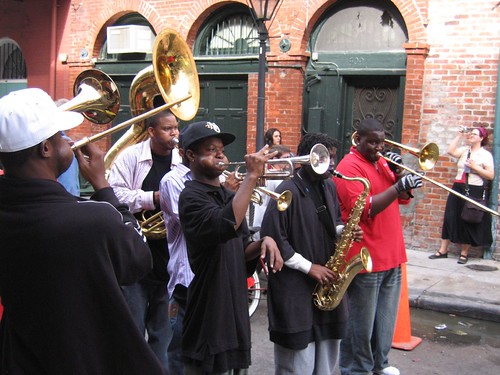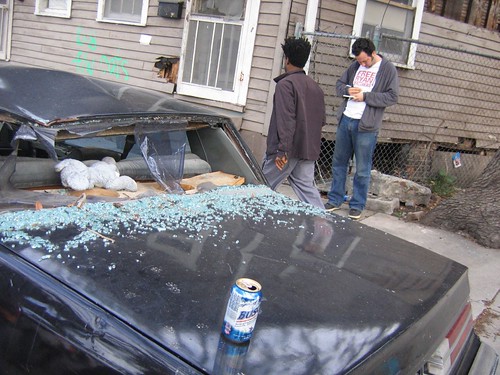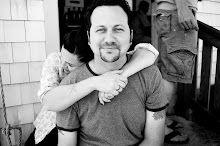

The Treme premiere depicted, I thought quite convincingly, the first post-Katrina second line parade three months after the flood.
I was at the real life first second line on November 26, 2005 (at least I thought it was the first) and wrote about it for The Nation a month or two later. It was the Black Men of Labor second line, originally scheduled for September 5, 2005 but delayed - not canceled - by the storm and executed in pretty spectacular fashion less than three months later. It was pretty terrific.
Nikki took phenomenal pictures, one of which ended up in my book. Here is what I wrote at the time:
A Second-Line Revival
By Billy Sothern
January 25, 2006
"In this place, there's a custom for the funerals of jazz musicians. The funeral procession parades slowly through the streets, followed by a band playing a mournful dirge as it moves to the cemetery. Once the casket has been laid in place, the band breaks into a joyful 'second line,' symbolizing the triumph of the spirit over death. Tonight the Gulf Coast is still coming through the dirge, yet we will live to see the second line." --George W. Bush, September 15, 2005
Word spread in bars, coffee shops and by way of New Orleans' independent radio station, WWOZ, that there was going to be a second line at 10 Saturday morning starting at Sweet Loraine's on Saint Claude Avenue. The parade was with the Black Men of Labor, who second-line annually on Labor Day. There were to be two brass bands, The Hot 8 and To Be Continued, a group of teenage musicians.
One documentarian, in a Yankees hat and with a large movie crew, was especially conspicuous. The storm had blown in Spike Lee, a genuine national celebrity. In a city that is just as eager to revere its own local celebrities--like Mister Quintron, an indie musician and inventor of the Drum Buddy; rock-star celebrity chef Susan Spicer; and the late Ernie K-Doe, singer of the 1960s R&B classic "Mother-in-Law" and self-proclaimed "emperor of the world"--Spike Lee attracted little more attention than the rest of the many cameramen as he worked on his new documentary, When the Levees Broke. No one had come to Sweet Loraine's to gawk at stars other than the dozen or so men in yellow shirts who were set to perform their distinctive dance up and down New Orleans' streets.
As we waited for the parade to start, an off-the-cuff press conference began, with cameras converging around the dapper men and people asking questions about the meaning of the second line after the storm. As New Orleanians are rarely at a loss for words these days in explaining their plight and the significance of their lives and culture (nothing like being left for dead by the rest of your country to make you realize that you have to speak up for yourself), Fred Johnson, one of the founders of the thirteen-year-old Second-Line Club, wearing a black fedora and dark glasses, responded at length, linking New Orleans' black cultural traditions to those of his ancestors, who were slaves in Louisiana. "Slaves created gumbo from the scraps off the table out of what no one else wanted," he said. "The big house didn't know what the little house was doin', but when they found out, it became a cuisine." He enunciated "cuisine" with slight mockery and derision but also with understanding--as, of course, who wouldn't want gumbo?
Not everyone was eager to listen to talking, though. Interrupting the monologue, a lanky middle-aged black man announced, "I came here to dance! Where's the music at?" He was soon placated by the booming moan of Bennie "Big Peter" Pete tuning his tuba. A heavy black woman with a tiny Nike backpack and big gold earrings, with a faint tattoo of an M on her hand, was ecstatic at the sound: "Bring me back home. Waah, waaah, waah, waaah. I been waiting to hear that. I been hearing it in my sleep."
As The Hot 8 tuned up, the Black Men of Labor disappeared into Sweet Loraine's, and the excitement of the promise of real New Orleans culture after months in the monoculture of Jackson, Houston and Pensacola spread among the crowd.
The Hot 8 began playing "E Flat Blues," and tears came to people's eyes as they gathered around outside, waiting for the second-liners to emerge from Sweet Loraine's. Then each player burst through the doors, one by one, like the hometown team coming onto the basketball court at the beginning of the game. Each man, dressed in the same yellow-and-black outfit, expressed an individual character coming through the darkened doors. Some sauntered, some strutted, and one particularly inspired dancer walked and danced in a squat with his butt almost on the sidewalk. Cheers for each of them were barely discernible over the loud brass.
When the last man was through, we began to walk, en masse, down Saint Claude Avenue, a street that runs through the now famously devastated Ninth Ward. The parade turned up Saint Bernard Avenue, and the brown, chest-heigh waterline became evident on the facades of people's old wood-frame shotgun houses.
As the band finished up "Paul Barbarin's Second Line," the dancers quickly headed into Mickey's Next Stop Bar, followed by about fifty paraders, all wanting a quick beer. It was unclear whether the bar just happened to be open at 11:15 on the parade route or whether these were normal hours in this near-vacant, crumbling neighborhood. But certainly, the few late-morning drinkers inside must have been surprised at all the company.
As sometimes happens here, we got sidetracked at the bar. This time the delay was justified by the fact that two critical components of the second line--beer and hot sausage po' boys, typically sold from the beds of pickup trucks following the parade--were absent.
The band got going again with a slow dirge as the parade resumed slowly up Saint Bernard into Tremé, one of the oldest black neighborhoods in America, where free people of color built homes in the mid-eighteenth century. We passed the neighborhood grocery store, the old Circle Grocery, which had become an emblem of New Orleans' post-Katrina chaos and was shown beneath deep water with nauseating frequency on CNN from the elevated interstate that runs next to it. The sad music captured the feeling so many of us had as evacuees looking at elements of our everyday lives turned upside down and projected to a national audience to tell the story of this terrible natural disaster.
The band, however, refused to dwell on this mood for long and commenced a rousing "I'll Fly Away," just as it passed under the interstate. With the sound trapped beneath the highway, the acoustics exploded. The band stopped marching and played even harder, as everyone cheered ecstatically.
When the song ended, the parade turned onto Claiborne Avenue, which runs under the highway and which served for generations as the center of commerce and social life for Tremé. It had been a wide neutral ground and once had elegant oaks under which families often picnicked. But the oaks were cut down and the neutral ground was paved for parking when the highway was built above Claiborne Avenue in the 1960s as part of a backward "urban development" plan. Recently, the oaks have reappeared as murals on the massive, concrete cylinders that support the highway, providing imagined shade to the many persistent families who still picnic there on lawn chairs, just as their great-grandparents did.
On the corner of Claiborne and Columbus, the parade made a left and lingered for a moment under the interstate again before the band and the Second Liners scurried over to Antoinette K-Doe. She was sitting on the corner in front of the Mother-in-Law Lounge, which she opened with her late husband as a venue for New Orleans music and tradition. Even before K-Doe's death, in 2001, it was a museum of artifacts from his career--it even contained a life-size K-Doe in one of his old '60s outfits. Almost all of the many images that adorned the walls featured K-Doe--with rare exceptions, including a painting of Christ. Since K-Doe's passing, Antoinette has been more open about the fact that the lounge is, and always was, a shrine to her legendary spouse.
Miss Antoinette is a revered figure in New Orleans among musicians of all stripes, from brass bands to indie rockers. In addition to her years as K-Doe's "wife, his manager, his secretary, his bartender, everything," as she described it to me recently, she is also a cousin of Lee Dorsey, the writer and singer of the New Orleans anthem and '60s R&B hit "Ya-Ya," as well as a singer and dancer in her own right.
All of the musicians and dancers stopped to check in with Miss Antoinette, offering condolences for the extensive flood damage that the lounge and K-Doe's old black limo suffered in the storm. She remained smiling, optimistic and proud in all of her exchanges as she sat against the bright-colored murals of musicians on the exterior cinderblock walls of the lounge. In sharp contrast, everyone could easily see past Miss Antoinette, through the doorway, into the gray and gutted lounge. As empress of all of this, Miss Antoinette greeted Spike Lee as she did everyone else, and posed with him for a picture taken by one of his crew, seemingly for him to hang on his office wall.
We got going again, down Columbus Street, a block that three months earlier had been an open-air drug market but that had since been abandoned to flooded cars and garbage, including a flood-darkened Ziploc bag with "pickled lips" handwritten on the white label. On the next block down, in the fenced-in schoolyard of the McDonough 35 High School, the parade approached a group of young black men in orange jumpsuits with "OPP" stenciled in black block letters on the chest. These men, prisoners of the Orleans Parish Prison, which only three months earlier had left hundreds of men to drown in their cells in the rising water, ran to the high, chain-link fence and danced to the rhythm of their home, their neighborhoods, with their fists in the air. Cute women in pigtails and handmade "Make Levees, Not War" T-shirts danced in the sunny street on the other side of the fence, framed against the burned-out shell of an old Creole cottage.
The Hot 8, no strangers to urban criminal justice, stopped and began a special performance for the men behind the fence, playing an impromptu "Let My People Go." This act of solidarity reminded me of the band's own loss when a year earlier, only about five blocks from the schoolyard, The Hot 8's trombone player, "Shotgun" Joe Williams, was killed by police. (Though the media made much of his nickname in justifying the shooting of this unarmed man, anyone familiar with local jazz could explain that "shotgun" is a colloquialism for the trombone.) While the band was scheduled to play to a mostly white, upper-middle-class crowd in the French Quarter later in the day, it is unlikely that audience received the same kind of passionate and personal performance that The Hot 8 gave for the men in the orange jumpsuits.
The parade wrapped up its tour of the Tremé in front of the Back Street Museum, a museum of New Orleans' black cultural history in the shadow of the old Saint Augustine Church, where generations of Tremé musicians were baptized. The staff had made red beans and rice, which they gave to the dancers and musicians, and then to everyone else. Some activists circulated a petition for Category Five hurricane levee protection, and others informed the crowd of a march the following week to protest the city's lack of commitment to rebuild poor neighborhoods. They passed out fliers with the South African antiapartheid anthem "Nothing Without Us Is for Us" providing the details. Everyone seemed optimistic and at home, and unlike almost any other place where New Orleanians congregate, no one talked at all about moving away.
We had, for a moment, lived up to the President's prediction and triumphed over the spirit of death with a second line through a city that had been left to die as he watched from the big house, while his wife no doubt explained to him that what we have down here is "culture."
(See photos of the second-line parade by New Orleans artist Nikki Page here.)


